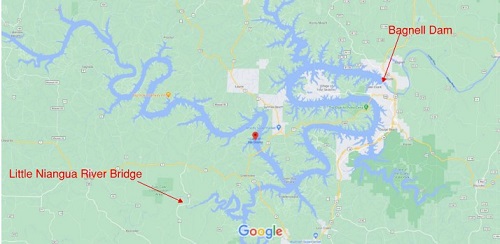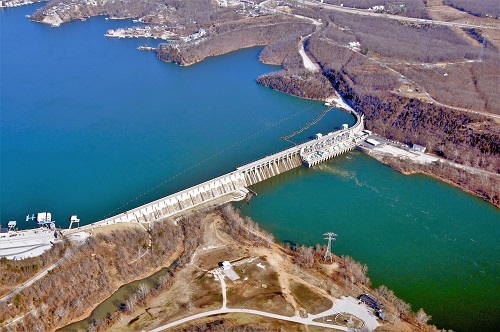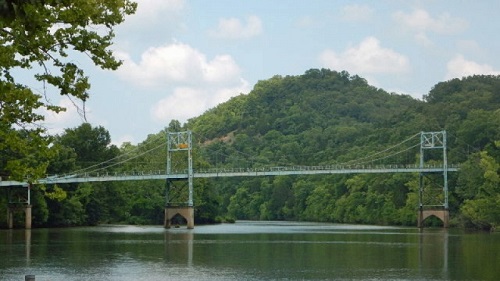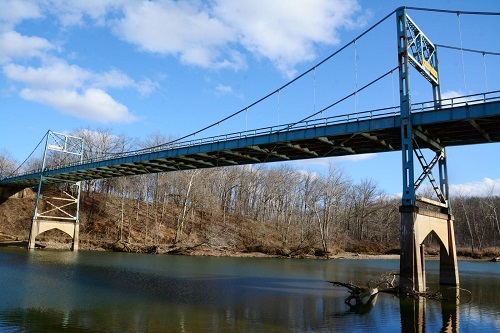https://bridgehunter.com/photos/38/45/384570-L.jpg
Until 2018, you could drive on in central Missouri on state Route J in Camden County, and cross the Little Niangua River on a little suspension bridge. The Little Niangua River feeds into the Lake of the Ozarks, which is a sprawling body of water that was formed in 1931 with the building of the Bagnell Dam.

Lake of the Ozarks- Google Maps

Bagnell Dam By KTrimble (talk) - Own work (Original text: I (KTrimble (talk)) created this work entirely by myself.), CC0, https://commons.wikimedia.org/w/index.php?curid=17982808
The lake extends far west and north from the dam. Part of the project included construction of bridges across its tributaries, which in some areas became much wider parts of the new lake and more difficult to cross. The Little Niangua River Bridge (aka Green’s Mill Bridge) was built in 1933. It is one of a short list of self-anchored suspension bridges built at that time, and one of the few structures of its type remaining.
The main span of the bridge is 225’ long. It has a steel grid deck and wire parallel strand cables. Bridge construction was funded in 1931, in part as mitigation for building of the Bagnell Dam, which flooded the river further east of the bridge site. Representatives from Camden County worked with the Missouri State Highway Department (MSHD) for the bridge design and construction. The Department consulted with the John A. Roebling’s Sons Company of Trenton, New Jersey about building a suspension bridge. It is not clear how the designers ended up with a suspension bridge, since some type of truss would have typically been chosen at that time. But in consulting the Roebling company, there is a hint of Brooklyn Bridge in the final design, and that is what was built.
The bridge was determined eligible for listing on the National Register of Historic Places as a nationally significant example of a self-anchored suspension bridge. At the time of construction, it was one of four self-anchored suspension spans. The others are the Three Sisters crossing the Allegheny River in Pittsburgh. These bridges are still in service.
The Little Niangua River is still standing, but unfortunately time has taken its toll. Regular bridge inspections found increasing deterioration, to the point where Missouri DOT made the decision to replace it. Because the structure has potential historic value, Missouri DOT is offering the bridge for free to organizations or individuals who can propose reuse in place.
The crossing is sited in a rural and rolling area of the Ozark Hills. Although the bridge is closed now, you can “virtually” drive across with help from Google Street View, which has photos before 2018. It is an astonishing drive. Route J crosses beautiful and remote terrain featuring bucolic woods and rolling farmland. You “drive” east on the photos, and suddenly the bridge appears. It is startling to see. The form of a suspension bridge is something we associate with the big city, but here is this little, unassuming bridge in the middle of the woods and farms. The structure is an evocative mashup of the big city superimposed on a rural landscape. It is definitely a suspension bridge, but it is a remote little bridge that looks transported out of space and time to a different place.
The Green Mill’s Historical Bridge society is looking to take Missouri DOT up on that offer. It is a non-profit organization which is seeking to preserve the bridge. I spoke with the society’s President, Lonetta Bartell, and she shared some thoughts:
Green’s Mill Bridge was one of five bridges constructed when the Lake of the Ozarks was created by constructing Bagnell Dam on the Osage River. Each of the five bridges spanned one of the five rivers that shape and send water into the “Dragon Lake” of the Ozarks.
Four of those five bridges have been demolished and replaced. Green’s Mill Bridge is the only one remaining and is no longer adequate for modern traffic on State Road J. Green’s Mill Bridge crosses the Little Niangua River just downstream from the confluence of the river and the lake.
My family would spend summer vacations at a campground just southwest of the bridge. Mom would take me along with my brothers and sisters to the bridge where I would listen with sincere interest as she shared stories about her childhood and what it was like living in the backwoods of the Missouri Ozark Hills. My mom is now gone. However, I still feel driven to take my own children and grandchildren to the bridge. As we stop to look at the breathtaking scenery that surrounds us, I think of mom as I share with them her stories from days gone by, include my own stories of vacationing here and to teach them a little bit about their heritage. Today I live one mile downriver from Green's Mill Bridge.
We formed a group to help preserve the bridge. Green’s Mill Historical Bridge, Inc, was organized in 2018 to:
1. Preserve and Maintain Green’s Mill Bridge in its original location
2. Make the bridge and Ozarks history accessible to visitors
3. Support bridge engineering history and education
Our organization has plans to develop the bridge as a handicap accessible facility. The deck is currently open steel grid. We will be laying recycled rubber that is ADA approved as walkways across the bridge. Part of the steel grate decking will remain. Chain link fencing will be installed on both sides just inside the original railing. A courtyard and handicap parking lot will be constructed on the northeast end of the bridge with a regular parking lot on the southwest end. Dusk to dawn lighting will shine over the complete bridge.
Use of the bridge will be offered for public gathering such as family reunions, weddings, memorial, sunrise or vesper church gatherings and fund raising events. The list is endless.
We plan to fund this project by offering memberships and accepting donations. We are currently holding a Capitol Campaign in order to get corporations and/or individuals to underwrite some of the continuing costs inherent in a project of this magnitude.
The society is taking on an impressive assignment in trying to preserve the old bridge. Future generations will appreciate the quirky and distinctive little bridge. You can imagine people congregating at the bridge in the Ozark summer for celebrations and festivities. A better way of appreciating this old and excellent little span cannot be found. We are looking forward to the society’s success.

https://www.modot.org/historic-bridge-little-niangua-river-bridge


Post a comment to this article
Report Abusive Comment